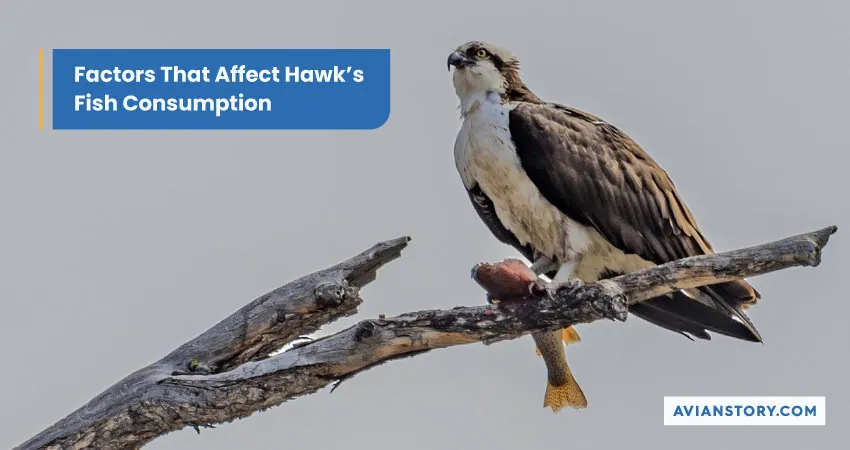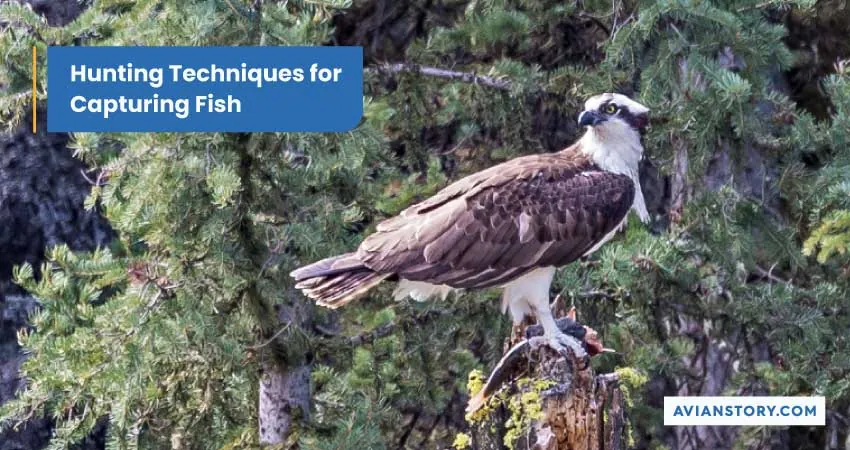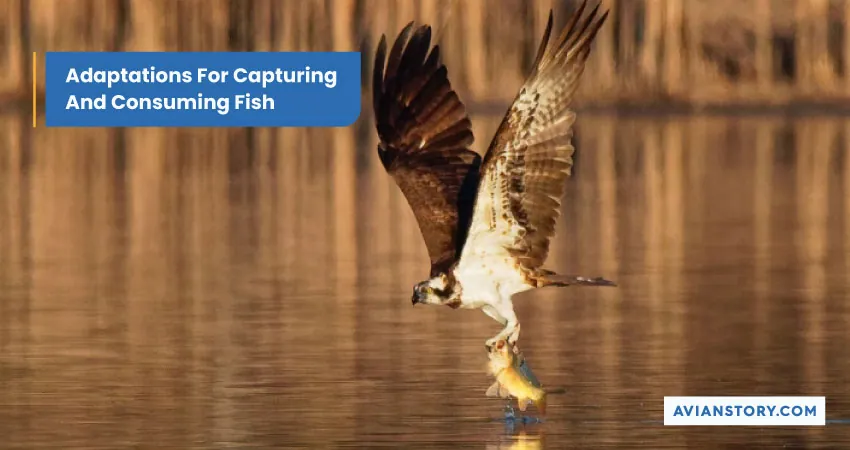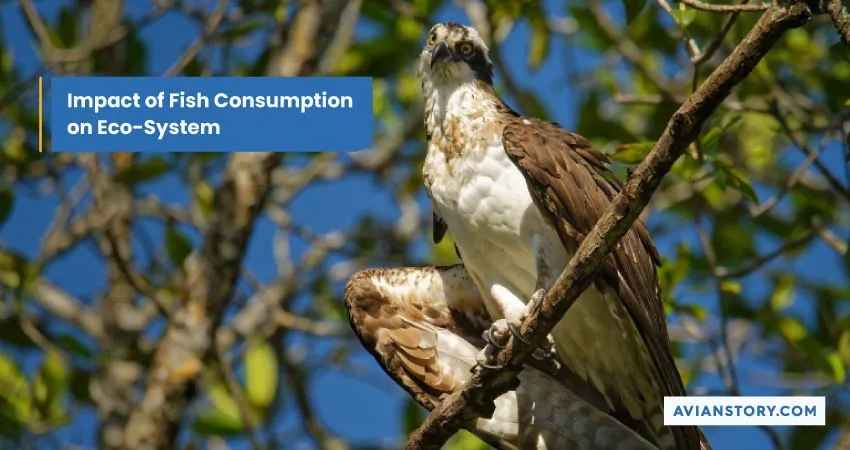Do Hawks Eat Fish? Everything You Need To Know
Hawks are carnivores and are commonly found in both rural and urbans across the states. While they are known to consume small animals, their presence near water bodies can be intriguing.
So, do hawks eat fish? With sharp talons, powerful wings, and a keen sense of sight, most hawks are specialized fish hunters. And certain species like the Osprey also consume them as a primary source.
Here we are going to discuss which species of hawks eat fish and what they prefer. Let us get to it.
Do All Hawk Species Eat Fish?

What do hawks like to eat usually? The diet of hawks can vary depending on the species, location, and of course, environment. Generally, they feed on rodents, voles, rabbits, snakes, lizards, grasshoppers, etc. Smaller hawks limit their diet to insects.
That is to say, do hawks eat birds too? Yes, they do. They eat small birds like sparrows, finches, and warblers. Basically, hawks eat anything that is less than their size. And that includes fish too.
But not all hawks eat fish. Some hawks are great fish hunters. And some avoid it altogether. Here we will discuss that:
A. Accipitridae Family
Hawks from the Accipitridae family have a sharp curved beak, talon, keen eyesight, and broad wings. All these features make them great predators of the wild. Here is a detailed overview of the food habit of these species:
1. Accipiters
Accipiters is a diverse family of hawks. They are a prominent part of the Accipitridae family. This type of species doesn’t usually feed on fish.
Their diet chart shows their food habit:
| Species | Diet |
| Goshawk | Small to medium-sized birds, mammals, and occasionally reptiles and fish |
| Cooper’s hawk | Mostly birds, some small mammals, fish and reptiles |
| Sharp-shinned hawk | Small to medium-sized birds, sometimes mammals and insects |
2. Buteos
Buteo hawks are known for their broad wings, tails, and soaring ability. Unlike Accipiters, this type of hawk includes fish in their diet. But it is not their primary food source.
Their usual diet includes
| Hawk Species | Primary Diet | Occasional Diet | |
| Red-tailed hawk | Small mammals, birds, reptiles, amphibians | Fish, insects, carrion | |
| Red-shouldered hawk | Small mammals (rodents, rabbits), amphibians, reptiles, birds | Fish, insects, carrion | |
| Broad-winged hawk | Small mammals (mice, voles), reptiles, amphibians, birds | Insects, carrion, fish | |
B. Harriers
Harrier hawks, also known as Circus hawks, are known for their distinctive facial discs. This helps them to locate and capture prey even in low light. Harrier hawks have long, narrow wings and a long tail. This type of hawk likes to prey on fish.
1. Northern Harrier
The Northern Harrier’s diet primarily consists of voles, mice, rabbits, ground squirrels, birds, reptiles, amphibians, and insects. This type of hawk doesn’t generally go for fish. Only when they absolutely have to. In some cases, they even feed on carrion as well.
Northern Harrier has a unique hunting technique. They often fly low over open fields or marshes, searching for prey by sound and sight.
2. Osprey /Pandionidae Family
Osprey (Pandion haliaetus) is a fish-catching predator. It is also known as the fish hawk, river hawk, and sea hawk. They have a unique hunting behavior of diving feet first into the water to catch fish. So, what kind of fish do these hawks eat?
C. Falconidae Family
Hawks are often used for some members of the Falconidae family, commonly known as falcons. Falcons are smaller in size compared to other hawks. They are known for their swift flight and exceptional hunting abilities.
Some of the well-known species of the Falconidae family include the Peregrine Falcon, American Kestrel, and Merlin. What is their eating habit? Let’s look at the chart:
| Hawk Species | Primary Diet | Other Prey |
| Peregrine Falcon | Medium size birds | Bats, insects, reptiles, fish, and occasionally small mammals |
| American Kestrel | Insects, small mammals, reptiles, and birds | Occasionally feeds on fish, amphibians, and crustaceans |
| Merlin | Small-medium size birds | Insects, reptiles, and small mammals |
Types of Fish Consumed by Hawks

Now that we know which hawks eat fish, let us know what kind of fish they prefer. Do hawks eat pond fish, river fish, or fish right out of the sea? Let’s discuss that now:
Freshwater Fish
Hawks like freshwater fish. They are easy to hunt, especially if the water source is close to their habitat. In freshwater, they usually catch trout, salmon, bass, and sunfish. That is to say, do hawks eat koi fish?
This is a matter of debate. This is not uncommon. If the food source is easy to obtain, they will eat fish from the pond, like small koi. So, if you are cultivating fish in your pond, be sure to cover it with a net.
Here is a video link to hawks hunting fish from a pond:
The amount of nutrients hawks get from freshwater fish can vary depending on the specific species of fish. The size and age of the hawk also matter here. In general, freshwater fishes are a good source of protein, vitamins, and minerals.
For example, a typical serving of rainbow trout contains approximately:
- Protein: 20 grams
- Fat: 4 grams
- Calories: 120
- Vitamin B12: 48% of the daily recommended intake
- Selenium: 47% of the daily recommended intake
- Phosphorus: 19% of the daily recommended intake
- Vitamin B6: 15% of the daily recommended intake
- Niacin: 13% of the daily recommended intake
- Potassium: 10% of the daily recommended intake
Saltwater Fish
Hawks generally do not eat saltwater fish. Because these fishes are not commonly found in their natural habitats. So, hawks have to fly a long distance to hunt them.
However, Ospreys may occasionally feed on saltwater fish when they migrate to coastal regions. Some good example is mullet, flounder, mackerel, herring, and anchovies.
From seawater, fish hawks usually get protein, omega-3 fatty acids, vitamins, and minerals such as calcium, phosphorus, and potassium. It really depends on the type of fish they are consuming.
Factors That Affect Hawks’ Fish Consumption

There are a few factors that actually affect the consumption of fish among hawks. These behaviors determine what fish they eat and how much they consume it. They are:
Geographic Distribution
The geographic distribution of fish is a crucial factor. It determines whether hawks can consume them or not. hawks that reside in coastal areas may have access to a wide range of saltwater fish. While those that have freshwater near them may consume more freshwater fish.
Habitat
The habitat of fish also plays a crucial role in their consumption. Some fish species prefer to reside in shallow water, while others prefer deep water.
hawks can’t usually dive deep into the water. So, the fish that swims around the surface range or mid-range is usually their food.
Fish Size
The size of the fish is another important factor. Large fish may be too large for some hawks to catch and consume. hawks usually prefer the prey that they can hold in their talons. So, they don’t hunt big fish.
Fish Behavior
The last but not least factor is fish behavior. Some fish species are highly mobile and can quickly evade predators. While others are slow-moving and easier to catch. The fish hawks adapt their hunting strategies according to the behavior of their prey.
Hunting Techniques for Capturing Fish

For hunting their prey, hawks follow a few techniques:
- Perching and Swooping: This technique is commonly used by Ospreys. This technique involves the hawk perching on a high point, i.e. a tree branch or rock. They overlook a body of water from there and search for fish.
When their prey is in sight, the hawk swoops down rapidly towards the water, extending its talons.
- Skimming and Snatching: Here the hawks will fly low over the water. Then use their beaks to skim the surface and snatch up small fish.
- Aerial Plunge-Diving: Here, the hawk will fly high above the water and then dive down. They often do it from great heights to catch fish.
- Opportunistic Scavenging: Hawks will sometimes scavenge fish that have already died or been killed by other predators. They may also steal fish from other birds, like eagles.
Adaptations For Capturing And Consuming Fish

Hawks have evolved for several years to hunt and consume fish. Their adaptation can be categorized into two sectors:
Physical Adaptations
Hawks physically adapted the following features for hunting.
- Talons: They have sharp and powerful talons that allow them to grip and hold onto their prey. The talons of fish-eating birds, such as Ospreys, have specialized spiny scales called spicules. It helps them to grip slippery fish.
- Beak: The beak of a hawk is typically long and sharply curved. It allows the bird to grasp and tear the fish.
- Vision: Fish-hunting have a special adaptation called a fovea that enables them to see underwater.
Behavioral Adaptations
Hawks have developed several behavioral adaptations to catch fish effectively.
- Patience: Hawks are patient hunters. They spend long periods perched near water sources, waiting for an opportunity to strike.
- Precision and Timing: Hawks are also precise and well-timed in their attack. They swoop down to capture fish at the perfect moment.
- Aquatic Hunting Techniques: Hawks have developed several techniques for hunting fish. They use it in appropriate situations.
Impact of Fish Consumption on Eco-System

Fish-hunting hawks plays an important role in the ecosystem, particularly in freshwater fishes. By consumption, haws control the populations of fish species. However, it sometimes causes trouble for fish breeders.
In addition, the feeding habits of hawks can also contribute to nutrient cycling within aquatic ecosystems. Fish consumed by hawks contain nutrients that can be transferred to the soil or water through defecation. It is a process of discharging fesses. Defecation provides essential nutrients for the growth of plants and other organisms in the ecosystem.
Human Impact on Hawks’ Fish Predation
Human activities can have both positive and negative impacts on hawks ‘ fish predation.
Fishes lose their habitat due to the construction of dams and other water management structures. Fish then tends to migrate to other riverine location. So hawks that eat fish in that location will only have limited food.
Another negative effect is pollution. In polluted water, fish can’t survive. So they either change their habitant or die. This means hawks won’t get much access to fish as they usually did.
Too much fish catching from rivers and seas also has a bad impact. When people catch too much fish from a water source, hawks don’t get much fish to hunt for themselves.
There are some positive effects too. Like, when people Stock bodies of water with fish for recreational fishing. Sometimes humans stock fish in the river and ponds for environmental gratification. This actually gives hawks more prey to hunt.
Also, people sometimes built bird gazing stations with a nice environment and food for birds. These stations prove to be a safe haven for hawks
Conservation Efforts
Through conservation efforts, we can easily preserve various species of hawks. Otherwise, they will be lost like many other birds in the past. We can take some precise steps as follows.
A. Habitat Restoration and Preservation
Hawks require suitable habitats to survive and thrive. Conservation efforts aim to protect and restore their habitats. Wetlands, rivers, and estuaries are critical for hawks’ survival. Especially the fish-hunting hawks.
Nest protection also safeguards the birds as they build their nests in trees and often near water bodies. These nest protection efforts aim to protect nesting trees and prevent disturbance.
B. Fish Population Management
These efforts aim to maintain sustainable fish populations and prevent overfishing. If the number of fishes decreases in the rivers and ponds hawks like Osprey lose their food source.
So it is important to manage the population of fish. Some common fish population management techniques include:
- Setting fishing quotas
- Regulating fishing gear and methods
- Monitoring and enforcing regulations
C. Education and Awareness Campaigns
This conservation process includes teaching people, especially fishermen and bird hunters, the importance of hawks. Especially their importance in the ecosystem and the impact of animal’s existence within the ecosystem for the future generations.
Conclusion
So, do hawks eat fish? Some hawks, like Osprey, Northern Harrier, Peregrine Falcon, American Kestrel, and Merlin, eat fish. While species like Osprey consume it as a primary source.
No matter how they eat it, fishes are an important part of the ecosystem. And Hawks consuming it is another equally important factor. Therefore, while fish management is necessary, we must take action to protect and conserve hawks as well.
And to do that, proper education and awareness in necessary for the conservation of such species and other wildlife in general.
Resources:
- https://www.britannica.com/animal/osprey-bird
- https://wildbirdvet.com/wp-content/uploads/2019/09/Ford-Raptor-Gastroenterology.pdf
- https://www.bioexplorer.net/extinct-birds.html/
